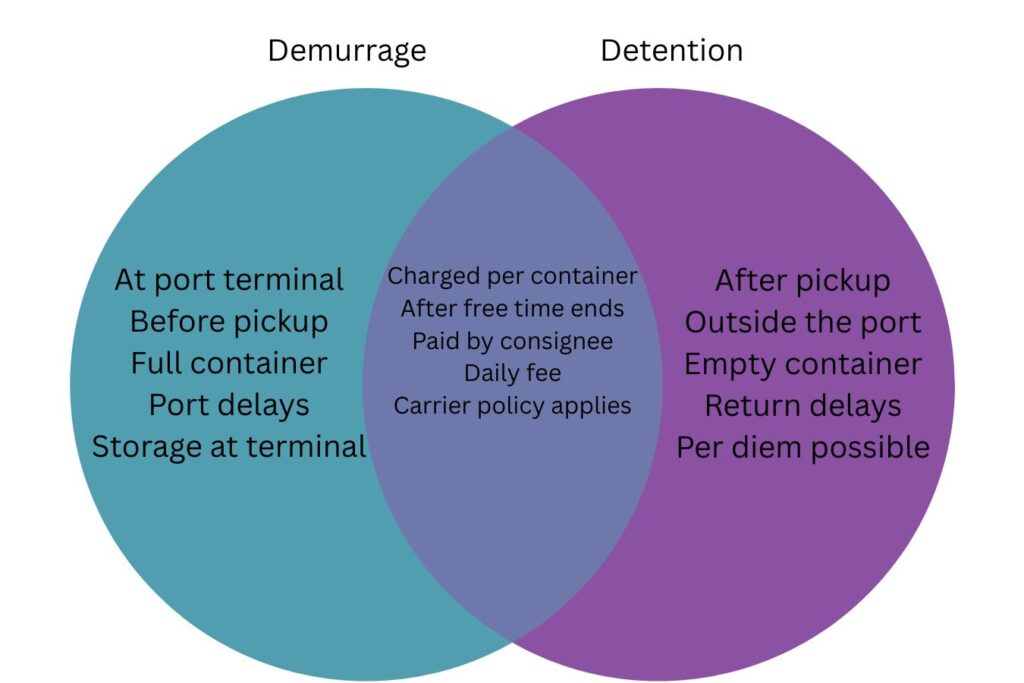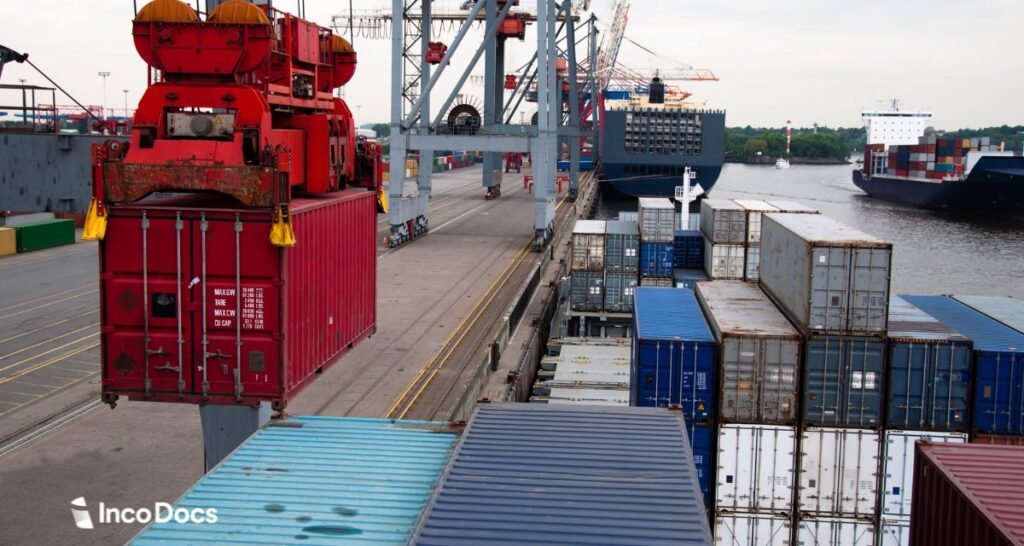In container shipping, delays can lead to unexpected fees. The two most common charges are detention and demurrage. These apply when cargo stays at the port terminal too long or when equipment is not returned within the allotted free time. Many importers and exporters confuse these charges, but each one applies at a different point in the supply chain.
By understanding what triggers detention and demurrage fees, shippers can avoid disruption, reduce costs, and keep cargo moving on time. This guide explains the difference between demurrage vs detention and how to manage both more effectively.
What is Demurrage?
Demurrage charges apply when shipping containers stay at the port terminal beyond the allotted free time. This free period gives the consignee time to pick up the cargo after it arrives. If the cargo is not picked up within the set number of free days, demurrage charges accrue daily.
Shipping companies use these fees to discourage delays and to keep containers moving. When containers sit too long at the terminal, it can slow down operations and reduce space for incoming shipments. Demurrage is charged per container and begins once cargo is available but not yet collected.
In most cases, the importer or consignee must pay the demurrage fee to the carrier or steamship line.
What is Detention?
Detention fees apply when a container leaves the port but is not returned on time. After the cargo is unloaded, the consignee must return the equipment within the allotted free time. If they don’t, the shipping line will charge detention fees for each extra day.
These charges are meant to discourage delays and keep containers in use. When the container stays outside the port too long, it creates problems for shipping companies and other customers.
Detention typically applies after pickup. The fee is charged per container. The importer or consignee is responsible for paying it.
The Difference Between Demurrage and Detention Fees
Some shipments can trigger both fees at once. This often happens when cargo is stuck at a port terminal due to slow customs, and the empty container is returned late. In these cases, shipping companies may apply demurrage and detention fees together. Knowing where the delay starts helps you act faster. If the cargo is still at the port, focus on clearing and pickup. If it has left the terminal, act quickly to return the equipment.
Here’s a clear comparison:
| Charge Type | When It Applies | Where It Applies | Who Pays |
|---|---|---|---|
| Demurrage | After cargo arrives but is not picked up | At the port or terminal | Importer or consignee |
| Detention | After pickup but before equipment return | Outside the port (e.g. depot) | Importer or consignee |
Example of how Demurrage and Detention Fees Work
A container of furniture arrives at the Port of Long Beach. The port gives the importer a set amount of free time. This allows five days to pick up the cargo. Due to a customs delay, the container is not collected until day eight. This results in three days of demurrage charges.
The container is then delivered inland. The importer has four days to return the equipment to the designated container yard. Because of a trucking delay and slow unloading, the equipment is returned on day six. This leads to two days of detention fees.
In this case:
- Demurrage was charged because the cargo stayed at the port beyond the allowed free time.
- Detention was charged because the equipment was returned late after the cargo was unloaded.

Common Causes of Demurrage and Detention Charges
Detention and demurrage charges are usually caused by delays during cargo handling. Some delays are preventable, while others are outside the importer’s control. Knowing what to look out for can help avoid detention and reduce costs.
Common causes include:
- Customs delays: Containers may be held for inspection. If clearance is slow, the free time can expire before you pick up your cargo.
- Documentation problems: Missing or incorrect shipping documentation can prevent cargo from being cleared by customs on time.
- Port congestion: High traffic at terminals can create slowdowns. Some carriers also charge detention if a return is delayed due to crowded depots.
- Transport shortages:4 A lack of trucks, drivers, or chassis can delay pickup or the return of empty containers. Coordination from carrier to carrier matters when timing is tight.
- Unplanned events: Strikes, weather, or natural disasters can delay plans. These can affect when you unload the cargo and return the equipment.
Causes Outside the Consignee’s Control
In some cases, charges can be triggered by factors outside of the consignee’s control, such as:
- Customs inspections or holds due to government regulations.
- Port or terminal congestion, causing delays in offloading or availability.
- Strikes by port or customs workers that slow down operations.
- Natural disasters or severe weather conditions that affect port or transportation infrastructure.
In these cases, carriers may offer flexibility, but often these charges still apply unless negotiated otherwise.
The Role of the Consignee
The consignee, usually the importer, is responsible for picking up cargo on time and returning the empty container. Failing to do so leads directly to demurrage or detention fees. Being prepared, having alternative transport options, and staying aware of potential delays are key to avoiding these extra charges.
The Impact on the Supply Chain
Demurrage and detention charges create disruption across the supply chain. They increase costs, delay delivery, and can make some shipments unprofitable. For companies with thin margins, even a few extra days of fees can break a deal.
These delays affect more than just cost. Late cargo can lead to stock shortages, missed deadlines, and lost orders. Over time, this weakens trust between shippers, freight forwarders, and carriers. When communication breaks down from carrier to carrier, it becomes harder to resolve delays in real time.
How to Avoid Demurrage Charges
Delays can happen at any point in the supply chain, but many detention and demurrage charges can be avoided with better planning. Here are key steps to reduce the risk of extra fees:
- Send documents early
Make sure all paperwork is sent to your customs broker well in advance. Missing or late documents are one of the top reasons cargo gets held at the terminal. - Work with experienced brokers
A good customs broker can clear cargo faster and avoid delays that lead to demurrage. They know what to check and how to flag risks before your shipment arrives. - Use real-time tracking
Track your shipments by staying in touch with your freight forwarder, shipping line, or agent. Real-time visibility helps you respond quickly if something goes off track. - Pick the right port
Some terminals have faster container handling and fewer delays. If you have a choice, use a port known for efficient operations. - Line up transport options
Delays often happen when no truck is available. Confirm your carrier early and have a backup in case the first one falls through. The faster you return the equipment, the lower the chance of detention.
What is Laytime in Shipping
Laytime is the agreed-upon timeframe for loading or unloading cargo at a port. It is often used in bulk or breakbulk shipping, where cargo does not move in containers. The clock starts when the vessel arrives and ends once the cargo is fully loaded or discharged.
If the cargo is not moved within the laytime, the shipowner may charge extra fees. These are often called demurrage in bulk shipping, but they differ from container demurrage. Laytime is written into the bill of lading or contract and should be reviewed carefully to avoid costly delays or disruption.

Other Charges: Per Diem, Driver Detention, and Storage Charges
Demurrage and detention are not the only charges that can impact your shipment. These related fees often apply in similar situations and add to total costs if not managed early.
Per Diem
Per diem charges apply when an empty container is not returned within the number of days allowed by the carrier. These charges are daily and continue until the equipment is returned. The goal is to keep container circulation moving and reduce shortages. Some carriers use a fixed rate per container, while others apply tiered pricing.
Driver Detention
Driver detention happens when a truck is delayed at a warehouse or unloading site. Most carriers allow one to two hours for loading or unloading. If the driver is held longer, hourly fees apply. This can disrupt schedules and affect the next delivery.
Storage Charges
Storage charges are billed by the port, not the shipping line. These apply when your container stays in port storage beyond the free time allowed. While similar to demurrage, these fees cover the use of physical space, not container equipment. Storage charges increase daily until the cargo is removed from the terminal.
Differences in Demurrage and Detention Practices Globally
Free time for detention and demurrage charges varies by region, port, and shipping line. Each carrier sets its own terms, but local rules and customs processes also shape how fees are applied.
United States
At major US ports, the standard free time is often 3 to 5 days. After that, demurrage and detention charges apply daily. Most carriers follow a fixed schedule, but charges increase the longer a container is delayed. Inland return options are limited in some areas, which can raise detention risk.
Europe
Free time in Europe varies by port and shipping line. Some terminals offer up to 7 to 10 days of extended free time, especially for inland destinations. Customs clearance in the EU can be more complex, so delays often relate to paperwork or regulatory checks.
Asia
Asian ports, especially in China and Southeast Asia, often provide 3 to 5 free days. Customs processes are strict and fast-paced. If documents are not complete, delays can lead to demurrage quickly. Some carriers in Asia also charge detention and demurrage together, depending on the port setup.
Carrier Variation
Terms can also vary carrier to carrier. Some allow you to purchase additional free time in advance, while others do not. Always confirm the agreed-upon free period for each shipment.
Negotiating and Managing Fees
Small-volume shippers may find it difficult to negotiate fee terms, but there are still ways to manage detention and demurrage costs more effectively. Carriers and port terminals set their own policies, but some flexibility exists depending on volume, timing, and relationships.
Here are a few ways to reduce exposure:
- Ask for extended free time upfront
If you ship regularly, you may be able to negotiate more than the standard number of free days. Some carriers offer 7 to 10 days instead of 3 to 5 for preferred customers. - Confirm terms in writing
Make sure the agreed-upon free time is included in your booking confirmation or bill of lading. If terms vary carrier to carrier, this protects you from unexpected charges. - Use delay documentation to request waivers
In some cases, fees may be waived due to port strikes, weather, or customs holds. Keep records and notify your carrier early if delays are beyond your control. - Know your carrier’s escalation policy
Some carriers raise fees in daily tiers. Understanding how demurrage charges are calculated helps you decide when to absorb costs or escalate with your freight forwarder.







